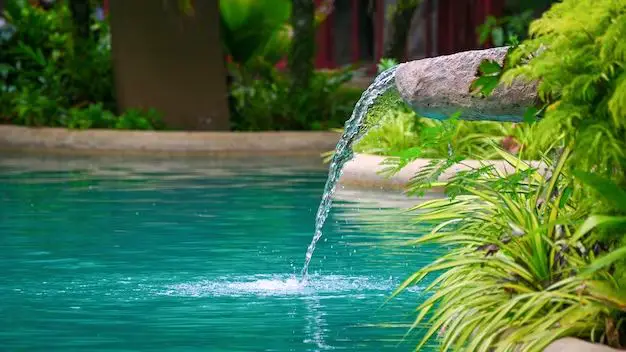Having a pond fountain can be a great way to add visual interest and soothing sounds to your backyard pond. However, pond fountains can sometimes become unstable and fall over, especially in high winds or storms. Fortunately, there are some simple things you can do to help keep your pond fountain upright and functioning properly.
Page Contents
- 1 Check the Base
- 2 Use Stakes or Cables
- 3 Place in Sheltered Area
- 4 Manage Pond Water Level
- 5 Maintain Fountain Balance
- 6 Remove for Severe Weather
- 7 Choose Durable Materials
- 8 Manage Algae Growth
- 9 Protect from Freezing Temperatures
- 10 Routinely Check Condition
- 11 Have Realistic Expectations
- 12 Consult a Professional
- 13 Conclusion
Check the Base
The base of your pond fountain plays a critical role in keeping it stable. Make sure the base is flat, level, and sits securely on the bottom of the pond. The base should cover a wide surface area and be weighted down sufficiently to prevent tipping. You can place large stones or bricks under and around the edges of the fountain base to help anchor it. Just take care that the electrical cord is not pinched under any heavy objects.
Use Stakes or Cables
Stakes and cables provide additional stability for top-heavy pond fountains. Drive metal or wooden stakes into the ground around the outside of the fountain and use plastic covered wires to tether the fountain to the stakes. Make sure there is some slack in the cables to allow for slight movement. You can also run cables over the top of the fountain to anchor the upper portion. Check the cables periodically to ensure they remain secure and replace them if fraying occurs.
Place in Sheltered Area
The placement of your pond fountain can make a difference in how well it withstands weather and winds. Position the fountain out of direct high wind paths and anchor it in a sheltered spot such as near the pond bank or behind plants and shrubs. Avoid open areas that get the full brunt of strong winds which can easily topple fountains. Consider a location that gets adequate sunlight for algae prevention but also provides shade during the hottest part of the day.
Manage Pond Water Level
Fluctuating pond water levels can undermine the stability of your fountain over time. As the water drops, the fountain base may get shifted and angled which makes it prone to falling. Check the water level frequently and top it off as needed to keep the fountain base submerged by at least a few inches. Account for increased evaporation during hot, dry weather which can rapidly lower pond levels.
Maintain Fountain Balance
An improperly balanced fountain may be more likely to tip over or lean to one side. Periodically inspect your fountain to ensure it remains perfectly vertical and evenly weighted on all sides. Make any necessary adjustments to the base to level it. Also check that water is flowing evenly out of all spouts. Uneven water flow can cause leaning and instability issues.
Remove for Severe Weather
Take extra precautions to protect your pond fountain during periods of severe weather when damaging winds or storms may arise. Consider temporarily removing very lightweight fountains and storing them in a safe place if high winds, hurricanes or tornados are forecast. For larger fountains that can’t be moved, fully secure cables, lines and anchors and reduce the fountain height if possible.
Choose Durable Materials
Pond fountains made of long-lasting, high-quality materials are less prone to being knocked over. Solid marble, concrete or metal fountain bases hold up better than hollow plastic or resin types. Metal pumps and tubing are also more durable for the wear and tear of the outdoor elements. Choose substantial anchoring stakes and thick, reinforced cabling for wiring.
Manage Algae Growth
Excess algae growth can make fountains slippery and more likely to shift position or fall. Control algae by maintaining proper water chemistry, using a pond clarifier and regularly scrubbing off any algae from fountain surfaces. Algae-covered pumps and tubing should be cleaned thoroughly to remove the buildup so water flows properly.
Protect from Freezing Temperatures
Allowing your pond fountain to freeze over in winter can cause the fountain to become unstable and crack or move when the ice expands and contracts. In cold climates, remove the fountain before the first deep freeze and store it in a protected area such as a garage or shed. An insulated fountain base or de-icer can also keep the water moving and prevent ice damage.
Routinely Check Condition
Get in the habit of regularly checking your pond fountain, especially after bad weather. Look for any signs of shifting, leaning or damaged components and make needed repairs immediately. Tighten cables, adjust the base if needed and replace worn parts like tubing or pumps that could contribute to instability issues.
Have Realistic Expectations
It’s important to have realistic expectations about the durability of pond fountains. Lightweight, inexpensive fountains may simply not stand up to some weather conditions. Focus on good design, quality materials and proper anchoring and maintenance if you want a very durable fountain. Also be prepared that you may need to replace fountains every few years as components wear out.
Consult a Professional
For very large or heavy fountains, consider having an expert pond installer assess your fountain design and anchoring plan. They can determine if additional stabilizing materials or measures are needed for your specific pond location and fountain choice. It’s best to get professional guidance upfront rather than trying to fix stability issues down the road.
Conclusion
Keeping your pond fountain upright requires a multi-pronged approach. A stable, level base, durable fountain materials, adequate anchoring and proper maintenance are key. Pay close attention to fountain placement and water levels as well. With smart fountain selection, setup and care, you can enjoy the beauty of a cascading pond fountain that remains reliably vertical for many years.
